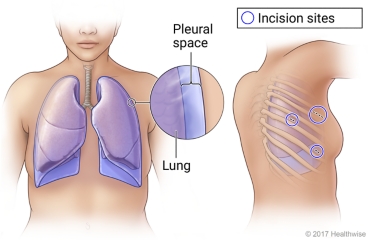What is thoracoscopy?

Thoracoscopy (say "thor-uh-KAW-skuh-pee") is a procedure your doctor can use to find and treat some problems in your chest. It may be used to take a sample of tissue for a biopsy. Or it can check for problems such as fluid collecting in the pleural space around your lungs (pleural effusion). It also can be used to drain extra fluid around your lungs and do a procedure to keep the fluid from coming back.
The doctor will make one or more small cuts (incisions) between your ribs. Then the doctor will put a thin, lighted tube with a camera on it into your chest. This tube is called a thoracoscope (say "thuh-RAY-kuh-skohp"), or scope. It lets the doctor see inside your chest. The doctor will close the incisions with stitches or staples. You may have a tube coming out of the area to drain fluid after the procedure.
How long you stay in the hospital and how long your recovery takes will depend on why you are having the procedure.
The scars from the incisions will fade with time. The area around the incisions may ache or feel numb in the weeks after the procedure.
How do you prepare for the procedure?
Procedures can be stressful. This information will help you understand what you can expect. And it will help you safely prepare for your procedure.
- Be sure you have someone to take you home. Anesthesia and pain medicine will make it unsafe for you to drive or get home on your own.
- Understand exactly what procedure is planned, along with the risks, benefits, and other options.
- Tell your doctor ALL the medicines, vitamins, supplements, and herbal remedies you take. Some may increase the risk of problems during your procedure. Your doctor will tell you if you should stop taking any of them before the procedure and how soon to do it.
- If you take a medicine that prevents blood clots, your doctor may tell you to stop taking it before your procedure. Or your doctor may tell you to keep taking it. (These medicines include aspirin and other blood thinners.) Make sure that you understand exactly what your doctor wants you to do.
- Make sure your doctor and the hospital have a copy of your advance directive. If you don’t have one, you may want to prepare one. It lets others know your health care wishes. It’s a good thing to have before any type of surgery or procedure.
What happens on the day of the procedure?
- Follow the instructions exactly about when to stop eating and drinking. If you don't, your procedure may be canceled. If your doctor told you to take your medicines on the day of the procedure, take them with only a sip of water.
- Take a bath or shower before you come in for your procedure. Do not apply lotions, perfumes, deodorants, or nail polish.
- Do not shave the surgical site yourself.
- Take off all jewelry and piercings. And take out contact lenses, if you wear them.
At the hospital or surgery center
- Bring a picture ID.
- You will be kept comfortable and safe by your anesthesia provider. You may be asleep during the procedure. Or you may get medicine that relaxes you or puts you in a light sleep. The area being worked on will be numb.
- The procedure will take about 1 hour.
Current as of: September 29, 2025
Author: Ignite Healthwise, LLC Staff
Clinical Review Board
All Ignite Healthwise, LLC education is reviewed by a team that includes physicians, nurses, advanced practitioners, registered dieticians, and other healthcare professionals.

